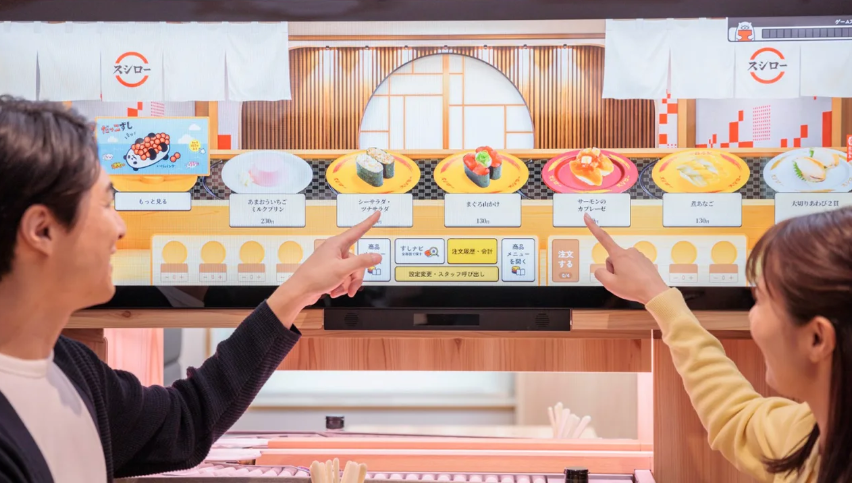
©FOOD and LIFE COMPANIES
Pre-reading questions:
I will read each question. Then, please answer them.
講師がそれぞれの質問を読むので答えましょう。
- Have you ever heard about a sushi restaurant with a digital conveyor system before?
- Do you think using touchscreens to order food in a restaurant could be a good idea?
Vocabulary:
I will read the words, meanings, and sample sentences. Then, repeat after me.
単語、意味、例文を読みます。講師に続いて音読しましょう。
- experience /ik-SPEER-ee-uhns/
- replace /ri-PLEYS/
- separate /SEP-er-it/
- deliver /dih-LIV-er/
- arrest /uh-REST/
[noun] – knowledge or skill from doing, seeing, or feeling something
Traveling to new places can be a wonderful experience.
[verb] – to take the place of something, or to put something or someone in the place of something or someone else
I need to replace the old lightbulbs with new ones because they’ve stopped working.
[adjective] – existing or happening independently or in a different physical space
The school has separate classrooms for different grade levels.
[verb] – to give, direct, or aim something
The postman will deliver the package to your house tomorrow.
[noun] – the act of arresting someone
The police made an arrest in connection with the recent burglary.
Article reading:
Please read the whole article. Then, I will check your pronunciation and intonation.
記事を音読しましょう。講師はあなたの発音とイントネーションを確認します。
Amid food safety concerns, Sushiro, a popular Japanese sushi chain, has upgraded its dining experience. In Tokyo, Osaka, and Nagoya, traditional spinning “kaiten” conveyor belts have been replaced with advanced ones. Customers can now order sushi and other dishes via touchscreen menus displaying food images. Once ordered, a separate conveyor delivers the selected items directly to the table. This high-tech solution aims to enhance food safety, customer satisfaction, and the overall dining experience.This change resulted from a problem called “sushi terrorism.” People copied viral videos, messing with food and sharing soy sauce on traditional Sushiro conveyor belts, leading to arrests and a big lawsuit. Akindo Sushiro is suing a high school student for 67 million yen ($480,000) after he tampered with sushi on a conveyor belt in a video on social media. This cost the company about 16 billion yen ($115 million) due to fewer restaurant visitors and a lower stock value. The new digital conveyor belts aim to boost hygiene and modernize dining after COVID, but they’ve split customers. Some like less food waste and better cleanliness, while others miss the old Kaiten style.
True or False:
Read the sentences and identify if they are true or false based on the article.
文章を読んで、記事に基づいて正誤を答えましょう。
- Sushiro has upgraded its dining experience due to concerns about food safety.
- The traditional spinning “kaiten” conveyor belts have been kept in Tokyo, Osaka, and Nagoya.
- Customers can order sushi and other dishes using touchscreen menus that display food images.
- Akindo Sushiro sued a high school student for 67 million yen ($480,000) because he tampered with sushi on a conveyor belt.
- The new digital conveyor belts aim to reduce food waste and improve cleanliness, according to the article.
Fill in the blanks:
Choose the correct word from the table then fill in the blanks.
適切な言葉を選んで空欄を埋めましょう。
| experience | replace | separate | deliver | arrest |
- The postal service will __________ your package tomorrow morning.
- My trip to the Grand Canyon was an unforgettable __________.
- The curtain served to __________ the living room from the dining area.
- The police made an __________ in connection with the robbery.
- It’s time to __________ the old, worn-out sofa with a new one.